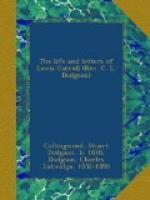Tis the voice
of the lobster; I heard him declare
“You have
baked me too brown: I must sugar my hair.”
As a duck with
its eyelids, so he with his nose
Trims his belt
and his buttons, and turns out his toes.
When the sands
are all dry, he is gay as a lark,
And talks with
the utmost contempt of the shark;
But when the tide
rises, and sharks are around,
His words have
a timid and tremulous sound.
I passed by his
garden, and marked, with one eye,
How the owl and
the panther were sharing a pie:
The panther took
pie-crust, and gravy, and meat,
And the owl had
the dish for his share of the treat.
When the plate
was divided, the owl, as a boon,
Was kindly permitted
to pocket the spoon:
But the panther
obtained both the fork and the knife,
So, when he
lost his temper, the owl lost its life.
The play, for the first few weeks at least, was a great success. Some notes in Mr. Dodgson’s Diary which relate to it, show how he appreciated Mr. Savile Clarke’s venture:—
Dec. 30th.—To London with M—, and took her to “Alice in Wonderland,” Mr. Savile Clarke’s play at the Prince of Wales’s Theatre. The first act (Wonderland) goes well, specially the Mad Tea Party. Mr. Sydney Harcourt is a capital Hatter, and little Dorothy d’Alcourt (aet. 61/2) a delicious Dormouse. Phoebe Carlo is a splendid Alice. Her song and dance with the Cheshire Cat (Master C. Adeson, who played the Pirate King in “Pirates of Penzance”) was a gem. As a whole the play seems a success.
Feb. 11, 1887.—Went to the “Alice” play, where we sat next a chatty old gentleman, who told me that the author of “Alice” had sent Phoebe Carlo a book, and that she had written to him to say that she would do her very best, and further, that he is “an Oxford man”—all which I hope I received with a sufficient expression of pleased interest.
Shortly before the production of the play, a Miss Whitehead had drawn a very clever medley-picture, in which nearly all Tenniel’s wonderful creations—the Dormouse, the White Knight, the Mad Hatter, &c.—appeared. This design was most useful as a “poster” to advertise the play. After the London run was over, the company made a tour of the provinces, where it met with a fair amount of success.
[Illustration: Medley of Tenniel’s Illustrations in “Alice.” From an etching by Miss Whitehead; used as a theatrical advertisement.]
At the end of 1886, “Alice’s Adventures Underground,” a facsimile of the original MS. book, afterwards developed into “Alice’s Adventures in Wonderland,” with thirty-seven illustrations by the author, was published by Macmillan & Co. A postscript to the Preface stated that any profits that might arise from the book would be given to Children’s Hospitals and Convalescent Homes for Sick Children. Shortly before the book came out, Lewis Carroll wrote to Mrs. Hargreaves, giving a description of the difficulties that he had encountered in producing it:—




